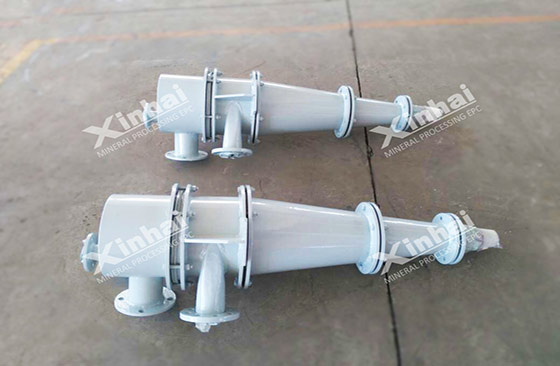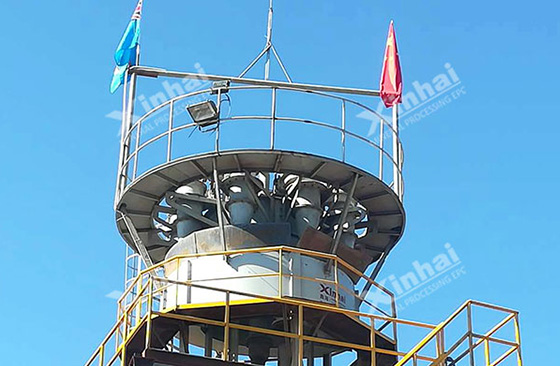
Classification operations often form a closed cycle together with grinding operations, so classification operations have an important impact on grinding. Since the fine-grained useful minerals and gangue minerals need to be dissociated, the ores need to be ground to a certain particle size and then sorted. In order to avoid the adverse effects of over-crushing and sludge on the separation process, the grinding products need to be classified, and the mineral particles that meet the requirements are sorted out and sent to the next stage of processing, while the unqualified mineral particles are returned to the grinding mill. Regrind in mining equipment. Commonly used classification equipment in mineral processing plants can be divided into mechanical classifiers and hydrocyclones. In the production process, there are many factors that will affect the classification efficiency. The following will introduce you to two factors that affect the working efficiency of the hydrocyclone.

(hydrocyclone)
(1) Hydrocyclone diameter: It mainly affects the processing capacity and classification particle size of the hydrocyclone. When the diameter becomes larger, the hydrocyclone processing capacity increases, and the classification particle size becomes coarser. Therefore, a 125mm diameter cyclone can be used for graded desliming of fine particles. When classifying coarse ore particles, a cyclone with a larger diameter can be used.
(2) Hydrocyclone feed port size: It mainly affects the classification efficiency, and it has a certain proportional relationship with the diameter of the cyclone. Generally, the ratio of the feed port diameter to the cyclone diameter is more suitable between 0.18-0.2mm. When exceeding this range, the processing capacity of the hydrocyclone can be increased, but the overflow ore particles will become coarser and its efficiency will also decrease.
(3) The size of the sedimentation port and overflow port: mainly affects the processing capacity, classification efficiency and classification particle size of the hydrocyclone. If the sand settling opening is small, there will be less sand settling and ore discharge. If the sand settling opening is large, the result will be opposite. When the overflow port of a hydrocyclone becomes smaller, its processing capacity will also decrease, and its overflow particle size will become finer. If the overflow opening becomes larger, the hydrocyclone processing capacity becomes larger and the overflow particle size becomes coarser.

(Hydrocyclone in mineral processing plant)
(4) Cylinder height and cone angle size: mainly affect the classification efficiency and classification particle size of the equipment. When the cylinder is higher or the cone angle is smaller, the hydrocyclone classification particle size becomes finer, and the efficiency increases accordingly. Therefore, hydrocyclones with high cylinders and small cone angles are suitable for graded desliming of fine particles.
(5) Insertion depth of the overflow pipe: mainly affects the classification efficiency and classification granularity of the equipment. If the insertion depth of the overflow pipe is too deep or too shallow, it will affect the classification efficiency of the equipment. It will generally be lower than the ore feeding surface and the lower edge of the cylinder.
(1) Feeding particle size: mainly affects classification efficiency. Keeping other conditions unchanged, if the feed particle size is coarse, the number of coarse particles in the overflow will increase, the sand concentration will increase, and the classification efficiency of the hydrocyclone will decrease. To solve this problem, you can choose to use a small diameter cyclone or increase the feeding pressure to improve the working efficiency of the equipment.

(cyclone group)
(2) Feed concentration and viscosity: mainly affect equipment classification efficiency and particle size. As the ore concentration increases, the concentration of overflow and sand settling slurry will also increase, the equipment processing capacity will also increase, and the overflow particle size will also become coarser. If the feed viscosity is high, the overflow particle size will become coarser, and the classification efficiency will be reduced.
(3) Feeding pressure: mainly affects the working indicators of the hydrocyclone. As the ore feeding pressure increases, the equipment processing capacity increases, the overflow slurry becomes finer, and the output and concentration of sedimentation will increase accordingly. It is worth noting that when the pressure exceeds a certain level, it no longer works. In actual production, in order to avoid affecting the classification efficiency, we should try to ensure operation under stable pressure conditions.
The above content is an introduction to the factors that affect the working efficiency of hydrocyclones. In actual production, there are many factors that affect its working indicators. These should be fully considered when using the equipment, so as to obtain good separation effects. Hydrocyclones are widely used in mineral processing plants. They can not only be used for classification, but also for desliming, concentration, and separation operations. Therefore, the correct and reasonable use of cyclones can further improve the production efficiency of the overall processing plant and increase economic benefits.
To find out more about our products and solutions, please fill out the form below and one of our experts will get back to you shortly.